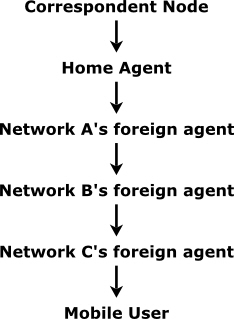
 Question
Question
Consider the chaining example discussed at the end of Section 6.7.2. Suppose a mobile user visits foreign networks A, B, and C, and that a correspondent begins a connection to the mobile user when it is resident in foreign network A. List the sequence of messages between foreign agents, and between foreign agents and the home agent as the mobile user moves from network A to network B to network C. Next, suppose chaining is not performed, and the correspondent (as well as the home agent) must be explicitly notified of the changes in the mobile user’s care-of address. List the sequence of messages that would need to be exchanged in this second scenario.
 Answer
Answer
Message Sequence list when the mobile user moving between foreign agents and home agent:
Mobile user visits foreign network A:
- Network A informs the home agent of the mobile user about his visit and registers COA.
- So, the mobile user’s datagram will be send to the care of address of mobile user in foreign Network A.
Mobile user moves to foreign Network B:
- When the mobile user moves to Network B, he is no longer belongs to Network A. Now the care of address of mobile user is in foreign Network B. The foreign agent in Network B conveys the same to the foreign agent in Network A.
- So, the mobile user’s datagram will be send to the care of address of mobile user in foreign Network A first and then to the Network B.
Mobile user moves to foreign Network C:
- When the mobile user moves to Network C, he is no longer belongs to Network B. Now the care of address of mobile user is in foreign Network C. The foreign agent in Network C conveys the same to the foreign agent in Network B.
- So, the mobile user’s datagram will be send to the care of address of mobile user in foreign Network A first, and then to the Network B, finally to Network C.
Example:
The following diagram illustrates the routing of mobile user’s datagram when the mobile user visiting Network C:

Discussions
 Savira Yousaf
Savira Yousaf
2nd scenario.
In the case that chaining is not used, the following events would happen:
• The mobile node arrives at A, A notifies the home agent that the mobile is now
visiting A and that datagrams to the mobile should now be forwarded to the
specified care-of-address (COA) in A.
• The mobile node moves to B. The foreign agent at B must notify the foreign
agent at A and the home agent that the mobile is no longer resident in A but in
fact is resident in B and has the specified COA in B. The foreign agent in A can
remove its state about the mobile, since it is no longer in A. From then on, the
home agent will forward datagrams it receives that are addressed to the mobile’s
COA in B.
• The mobile node moves to C. The foreign agent at C must notify the foreign
agent at B and the home agent that the mobile is no longer resident in B but in fact
is resident in C and has the specified COA in C. The foreign agent in B can
remove its state about the mobile, since it is no longer in B. From then on, the
home agent will forward datagrams it receives that are addressed to the mobile’s
COA in C.
When the mobile goes offline or returns to its home network, the datagram-forwarding
state maintained by the foreign agent in C must be removed. This teardown must also be
done through signaling messages. Note that the home agent is always aware of the
mobile’s current foreign network. However, the correspondent is still blissfully unaware
of the mobile’s mobility.
Post the discussion to improve the above solution.















